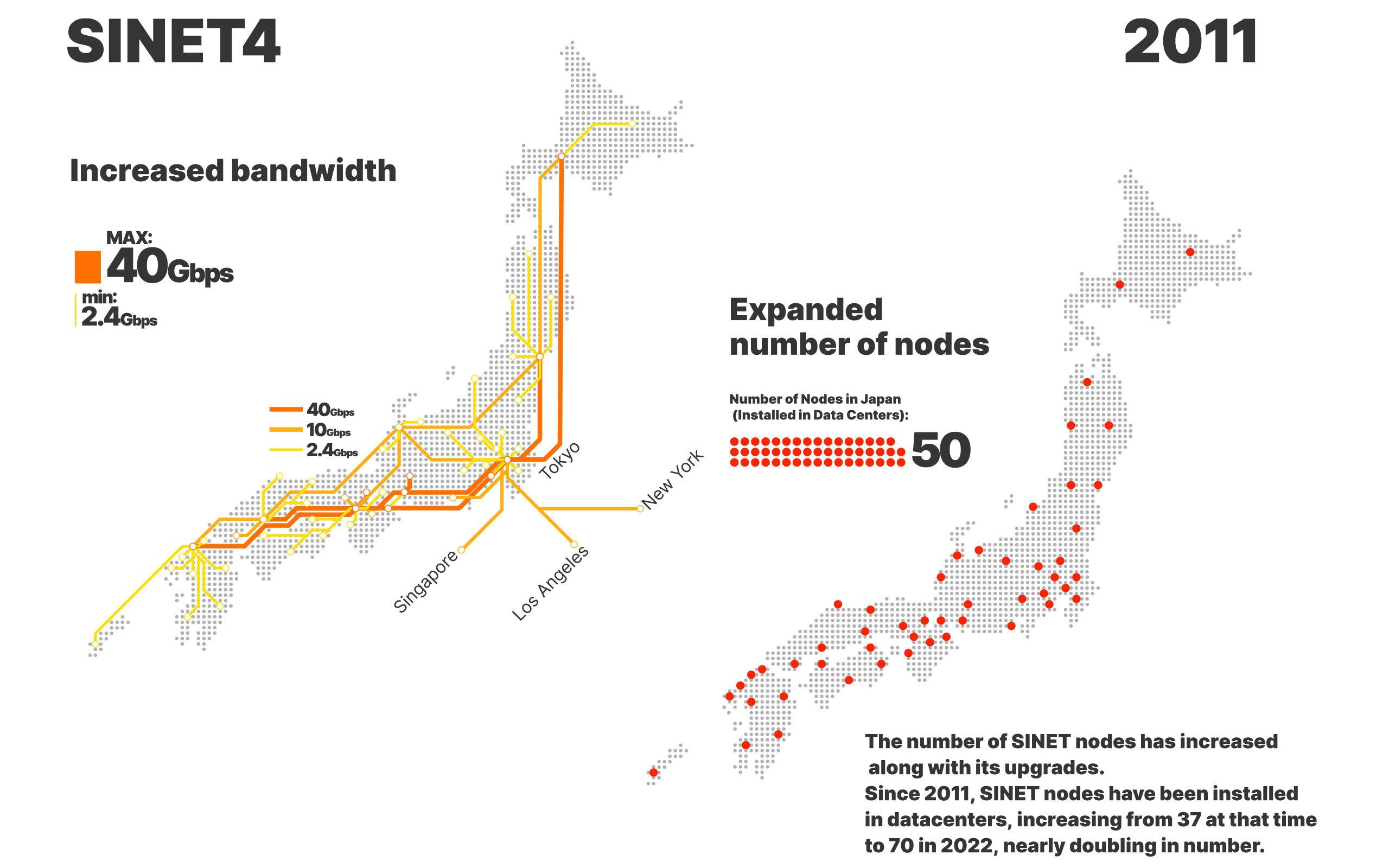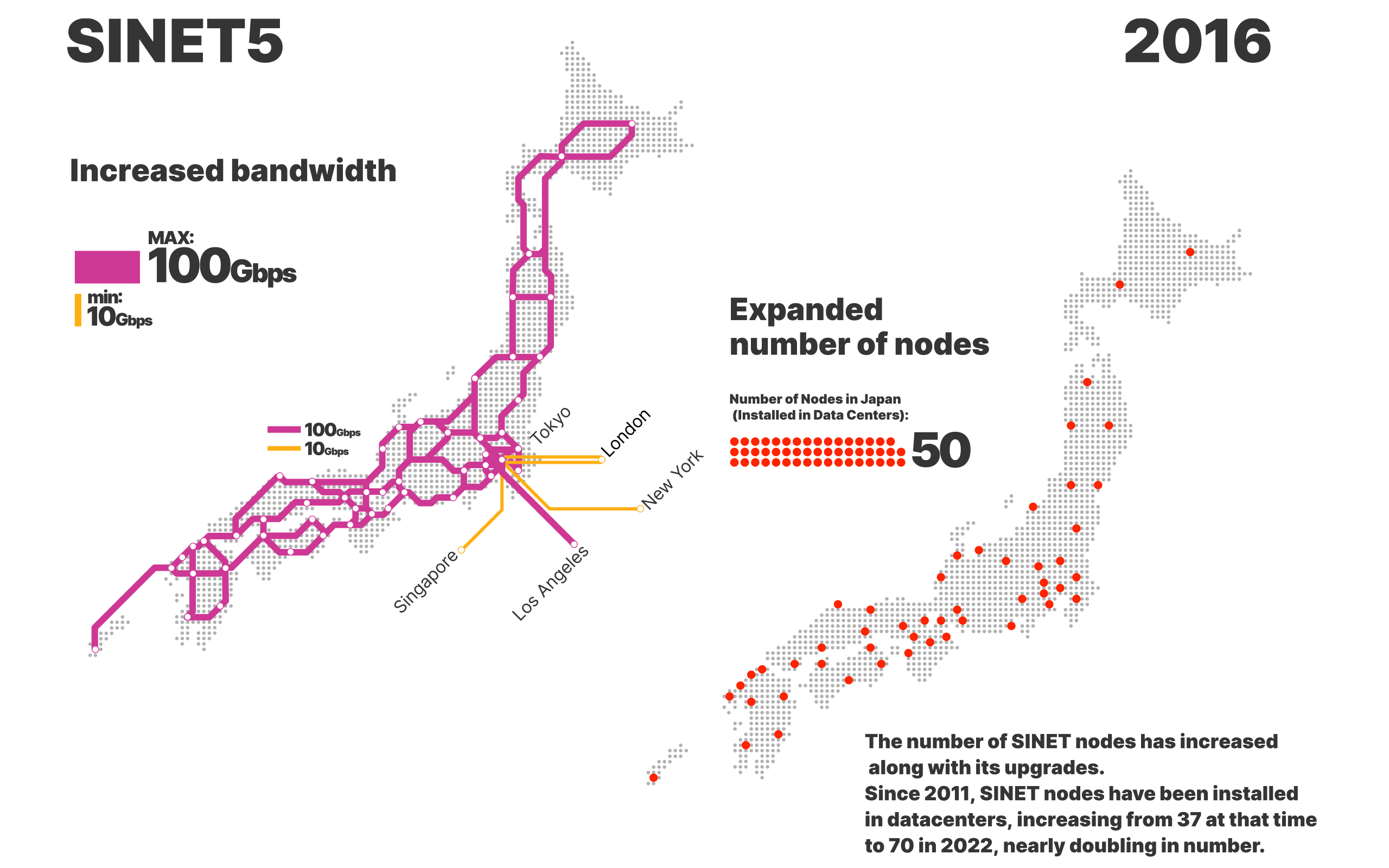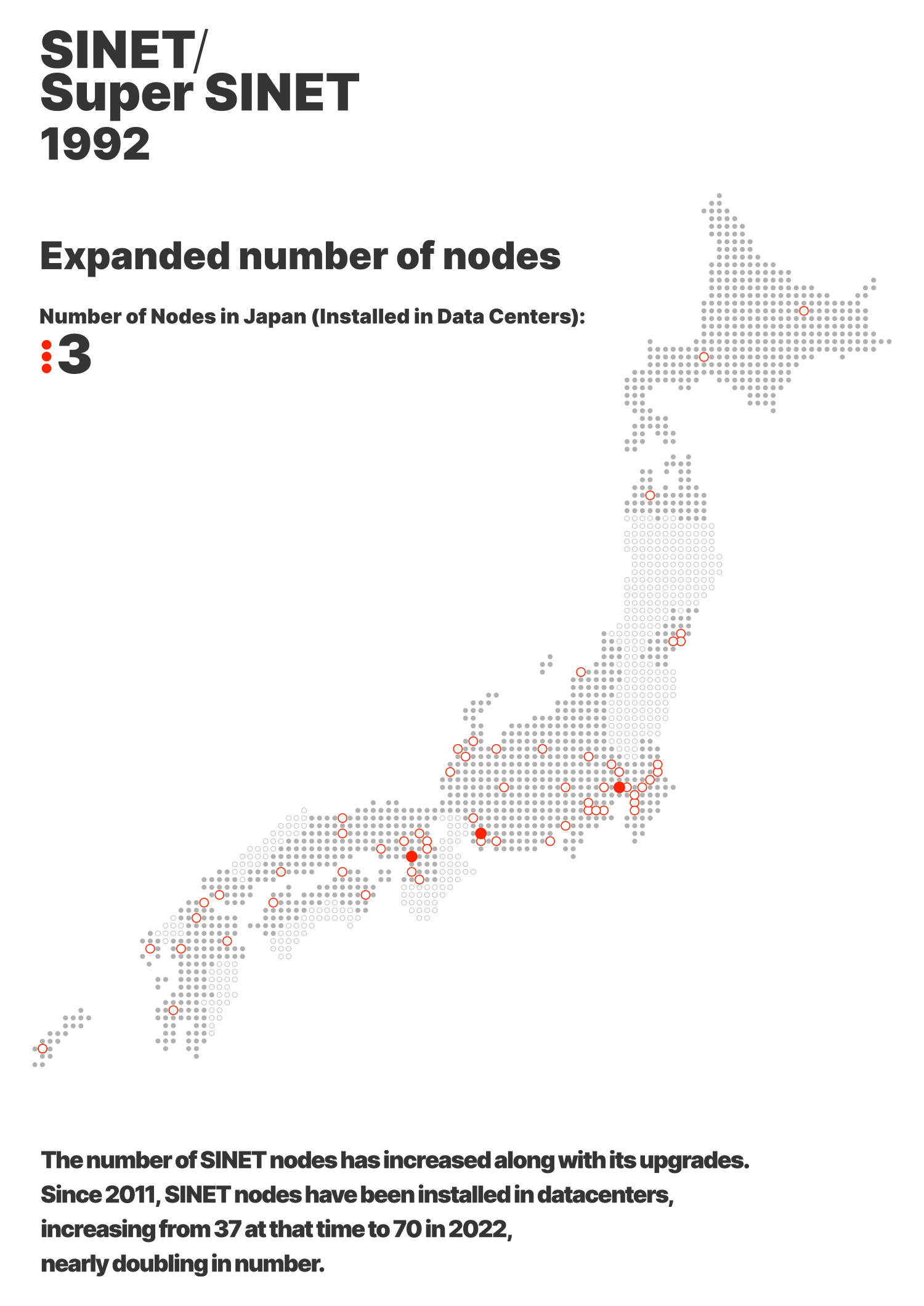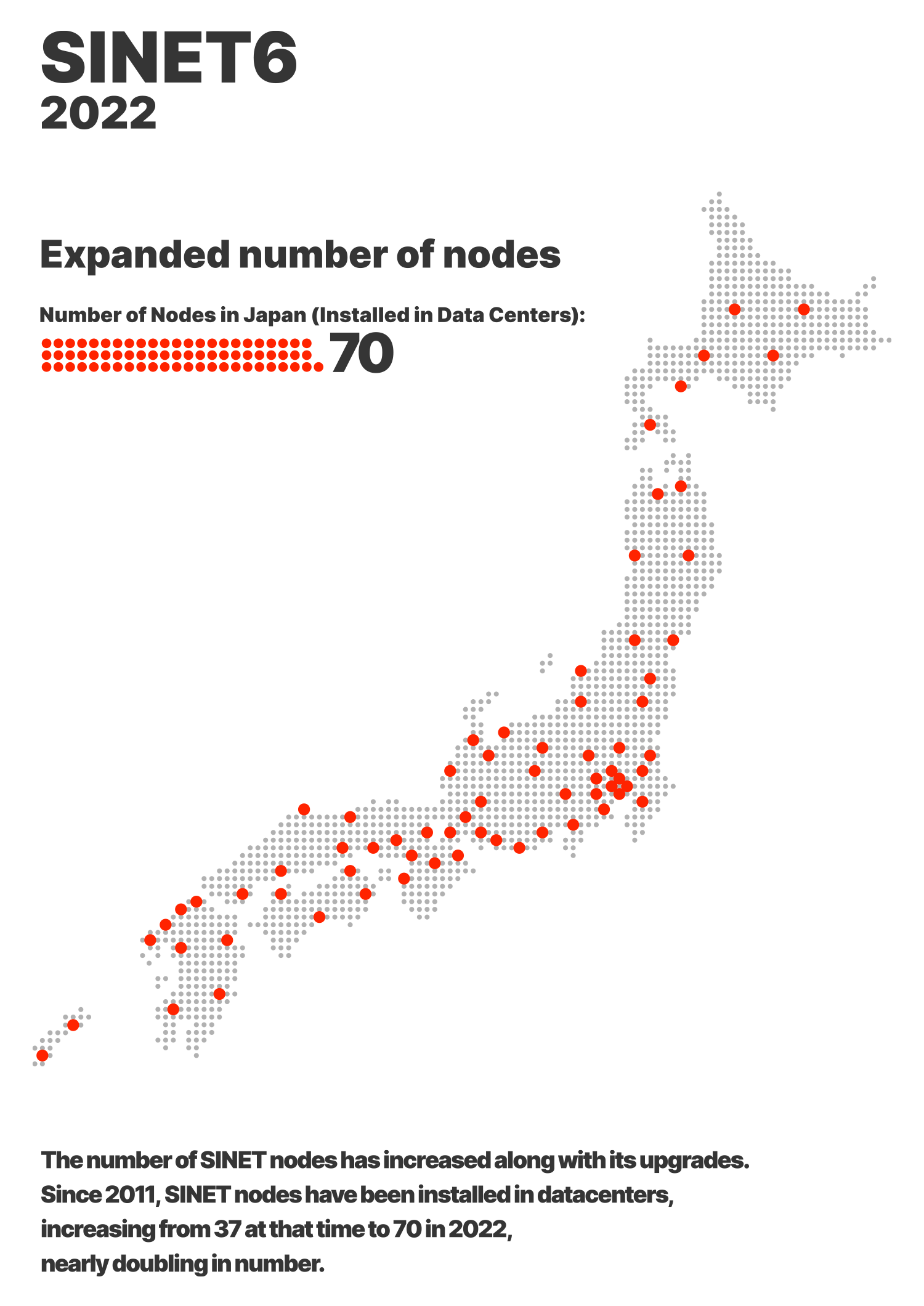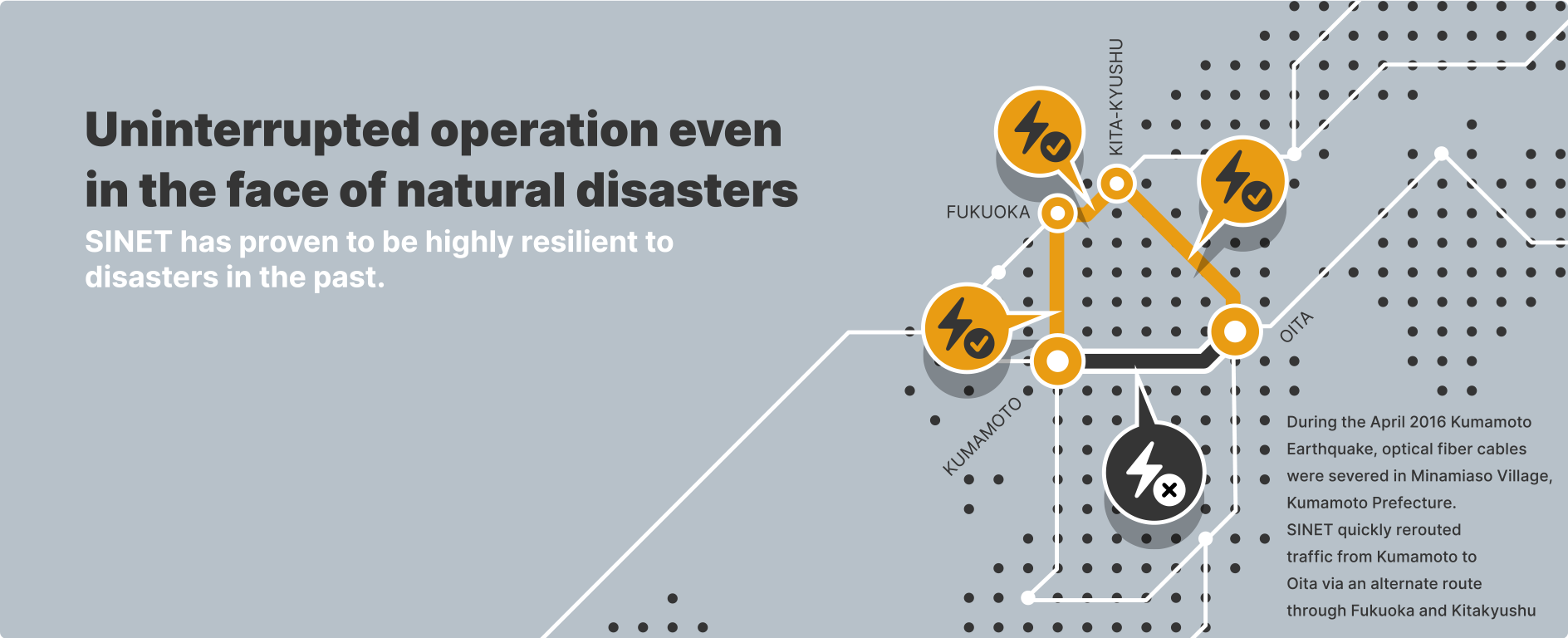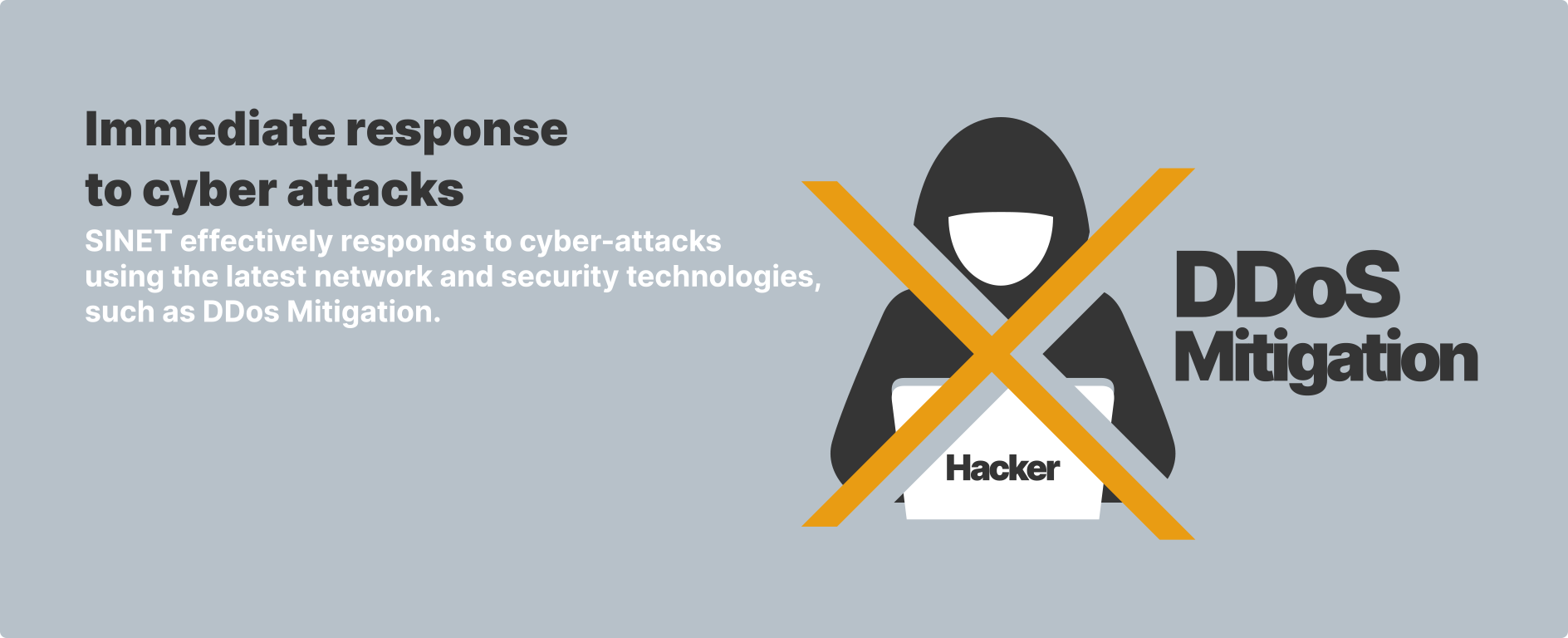SINET Features
Advanced features
SINET connects any points with the shortest route and ultra-high speed. The ability to send and receive data instantly reduces stress and enhances research performance.
Ultra-high speed
The nationwide 400 Gbps ultra-high-speed network enables 25 gigabytes of data (equivalent to one Blu-ray disc) to be sent anywhere in the country in just 0.5 second.
High reliability
By implementing rerouting capabilities in a multi-layered approach, SINET ensures continued stable operations during disasters like the Great East Japan Earthquake by maintaining connectivity through alternate routes when primary lines are disrupted.
Internationality
Through dedicated ultra-high-speed international connections linking the United States, Europe, and Asia, SINET provides a fast, stress-free, and secure communication with overseas research institutions.
High functionality
SINET supports diverse developments in academic information infrastructure such as cybersecurity, cloud utilization support, and academic content. Additionally, it supports research activities by providing advanced network services not available commercially.
SINET Use Cases
-
 Data Collection Using Mobile SINET for Emergency Risk Assessments of Buildings After EarthquakesThe Earthquake Research Institute, the University of Tokyo is using the Mobile SINET Demonstration Experiment (Mobile SINET) to perform emergency risk assessments of buildings after an earthquake. We spoke to Koichi Kusunoki of the Disaster Mitigation Division and Hiroshi Tsuruoka, Head of the Earthquake and Volcano Information Center, about the aims and progress of this initiative. (Interview date: December 5, 2023)
Data Collection Using Mobile SINET for Emergency Risk Assessments of Buildings After EarthquakesThe Earthquake Research Institute, the University of Tokyo is using the Mobile SINET Demonstration Experiment (Mobile SINET) to perform emergency risk assessments of buildings after an earthquake. We spoke to Koichi Kusunoki of the Disaster Mitigation Division and Hiroshi Tsuruoka, Head of the Earthquake and Volcano Information Center, about the aims and progress of this initiative. (Interview date: December 5, 2023) -
 Collecting Weather Information in the “Zekkei Project” Data-Driven Tourism Project Using SINET6In April 2022, Kitami Institute of Technology merged its academic corporation with two universities, Obihiro University of Agriculture and Veterinary Medicine and Otaru University of Commerce, to establish the Hokkaido Higher Education and Research System.
Collecting Weather Information in the “Zekkei Project” Data-Driven Tourism Project Using SINET6In April 2022, Kitami Institute of Technology merged its academic corporation with two universities, Obihiro University of Agriculture and Veterinary Medicine and Otaru University of Commerce, to establish the Hokkaido Higher Education and Research System.
SINET History
The predecessor of SINET was launched in 1987 as a packet-switching network. In 2022, SINET6 began operation.
SINETARIUM ii
Content visualizing the evolution of SINET
SINET's Achievements
Institutions Collaborating with SINET
Experimental facilities,
supercomputers and observation devices
supercomputers and observation devices
SINET collaborates not only with experimental facilities at universities, but also with the world's most advanced large-scale experimental facilities, such as HPCI (High Performance Computing Infrastructure), high-energy particle accelerators, and neutrino detectors.
International collaborative facilities
SINET collaborates with global facilities in various fields, including high-energy research, fusion energy research, space exploration, and geodetic projects that measure Japan’s geographical positioning.
Scientific information and mdx
Through collaboration with research data platform, GakuNin RDM, and mdx that support research, SINET enables the rapid and efficient utilization of data science and information science insights, various data, and software.
Cloud computing
SINET directly connects with cloud service providers, making it easy for academic institutions to access services such as storage, academic affairs systems, computing resources, and housing. Academic institutions can contract with preferred service providers and then securely and safely utilize cloud services through SINET's closed network (L2VPN).

Services Provided by SINET
NII undertakes the entire process of designing, constructing and operating an advanced network that leverages the latest technology.
It provides ultra-high-speed and diverse services surpassing those of general networks to meet the very large demand for cutting-edge academic research.
It provides ultra-high-speed and diverse services surpassing those of general networks to meet the very large demand for cutting-edge academic research.
Internet Access Services

IP Dual Service
Provides ultra-high-speed Internet access
QoS control and IP multicast services, which allow simultaneous data transfer to multiple destinations, are also available.
It supports both IPv4 and IPv6 Internet protocols.
It supports both IPv4 and IPv6 Internet protocols.
VPN Services

Virtual University LAN
Allows you to configure more than 100 virtual LANs
It can configure more than 100 VLANs (virtual LANs) connecting multiple campuses.

Cloud Connection (Dedicated L2VPN for Direct Cloud Access)
Enables direct communication with commercial cloud services without going through the Internet.
A total of 33* commercial cloud service providers across the country are directly connected to SINET.
Using L2VPN, you can securely use these cloud services as if they were on your own campus.
*As of July 1, 2024
Using L2VPN, you can securely use these cloud services as if they were on your own campus.
*As of July 1, 2024
On-Demand Services

Layer 2 (L2)
On-Demand
On-Demand
Customizes and configures your VPN as needed.
It is possible to guarantee communication bandwidth or specify the communication routes to adjust latency. For example, for video research, researchers can use a GUI to specify routes and increase latency, allowing them to observe the effects on video display.

Mirror On-Demand
Analyzes the causes of suspicious traffic
NII-SOCS* uses this feature to copy portions of network traffic as needed and send them to analysis devices to check for suspicious traffic.
*NII provides the NII Security Operation Collaboration Services (NII-SOCS) to help national university corporations and other institutions respond quickly to incidents and accidents related to cyberattacks.

Filter On-Demand
blocks traffic from suspicious IP addresses
FOD automatically blocks traffic from the suspicious IP addresses upon receiving instructions from NII-SOCS.
Other Services

Automatic
DDoS Mitigation
DDoS Mitigation
Notifies of and controls cyberattacks quickly
It protects against cyberattacks to ensure a safe, comfortable network environment.
It automatically detects and blocks DDoS attacks and mitigates communication impact even in the event of large-scale attacks at the 100-Gbps level. It continues to automatically block the attacks until they cease.
It automatically detects and blocks DDoS attacks and mitigates communication impact even in the event of large-scale attacks at the 100-Gbps level. It continues to automatically block the attacks until they cease.
Access Lines
Redundancy Service
Redundancy Service
Significantly reduces the risk of communication disruption
Provides redundancy for data center connections
Provides redundancy for data center connections
By connecting to SINET using multiple access lines from a university, communications can continue via other access lines if one fails.
With Data Center Connection Redundancy Service, the access lines are connected to different devices, significantly enhancing reliability.
With Data Center Connection Redundancy Service, the access lines are connected to different devices, significantly enhancing reliability.

BGP Looking Glass
Internet connection visualization tool
It visualizes how the lines in use are connected to the global Internet through various routes. Users can verify the network speed and performance yourself.

Performance Measurement (perfSONAR)
Network speed visualization tool
Users can verify the network speed and performance themselves.

MMCFTP
Automatically adjusts the number of logical communication lines
When transferring data over long distances (e.g., transferring data from overseas), it can maintain a consistent transfer speed by automatically assessing the condition of the communication lines.
Ultra-high-speed data transfer is also possible, with experimental examples of data transfer at speeds of up to 1 Tbps.*1
By combining MMCFTP with QoS control and setting the communication priority to the lowest level*2, it is possible to achieve high-speed data transfer without affecting other general network traffic.
Ultra-high-speed data transfer is also possible, with experimental examples of data transfer at speeds of up to 1 Tbps.*1
By combining MMCFTP with QoS control and setting the communication priority to the lowest level*2, it is possible to achieve high-speed data transfer without affecting other general network traffic.
*1: 1 Tbps = 100 Gbps (12.5 GB/s) multiplied by 10 = 125 GB/s
*2: Lowest Priority (Less Than Best Effort): A QoS class with lower priority than the general traffic QoS class (Best Effort)

QoS Control
Utilizes router buffer to automatically prioritize the transfer of high-priority data.
When a network path becomes congested, data is transferred based on priority. If the incoming data volume exceeds the capacity of the communication line, excess data may be discarded. By increasing the priority of critical data, it can be transferred preferentially and protected from being discarded.











